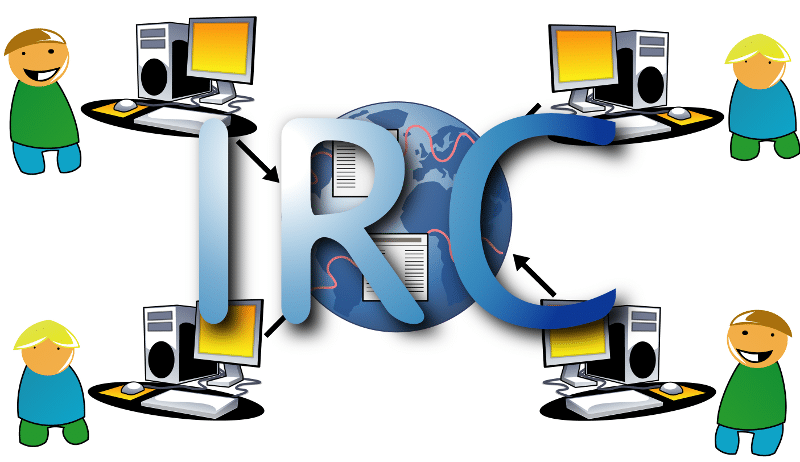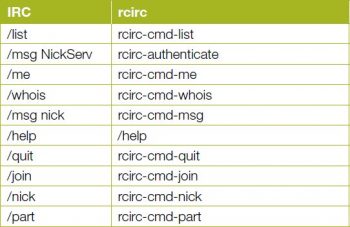Internet Relay Chat (IRC) is a messaging protocol that was created by Jarkko Oikarinen in 1988. An IRC server has a number of channels (or rooms, as they are called in other chat software) where both technical and non-technical discussions take place. Every user requires a nickname to chat. You will need to register your nickname with a password to identify yourself every time you log in to the IRC server. IRC can also be used for file sharing among users.
You can connect to a number of freely, available IRC servers. The most popular is Freenode (irc.freenode.net). The other IRC servers, to name a few, are IRCNet, OFTC, and EFNet. The Debian and Ubuntu projects have their own chat servers irc.debian.org and irc.ubuntu.com. All IRC channel names begin with #. Some channels begin with ##. Examples of channels are ##linux-india, #dgplug, #emacs, #ruby, #guile, #lisp, and #scheme. You can also create your own channels, or host your own IRC server. Some examples of free and open source IRC server software are IRCd, UnrealIRCd and Synchronet. Each IRC channel has a topic that can include useful links relevant to the channel. Sometimes, announcements or news updates are also mentioned in the topic.
Basic commands
A number of commands can be given to the IRC server. A few of them are discussed below:
1. /list is used to provide a list of all the available channels in a server. For example, /list in irc.freenode.net returned the following:
... #linod 1 ##welding 3 Welcome to ##Welding, Were a little bare at the moment, but will help if we can. Tutorials: https://www.youtube.com/channel/UCJAFY2kKKb5sg79yld7T3hA #drupal-ph 1 Drupalista! Welcome to Philippine Drupal Users Group. Have a good time chatting. If you have a question, please dont ask to ask but fire up your question in very specific and constructive way! Please join #drupal or #drupal-support if no one is around #orx-project 4 Orx: Portable Game Engine #tinkerforge 5 #osi 10 The Open Source Initiative #xampp 1 #guitar 8 #bitcoin-ar 3 Comunidad Bitcoin Argentina #LargeHadrosaurCollider 19 Welcome to the LHC, est. 2001 | http://www.largehadrosaurcollider.net | August Birthdays: Digby 08/21, Josh 08/31 | At night it is pitch black, often for months. | http://tinyurl.com/psgdagl * End of /LIST
2. /msg NickServ REGISTER password e-mail is used to register your nickname to the IRC server. /msg NickServ IDENTIFY password is used to identify yourself to the server.
3. /me message displays the message for a user. For example:
/me says Hello, World! * mbuf says Hello, World!
4. /whois nickname provides useful information for a user. For example:
/whois mbuf * [mbuf] (~shakthi@123.123.123.123): Shakthi Kannan * [mbuf] #guile #scheme ##linux-india #stumpwm #guix #dgplug #lisp #emacs * [mbuf] kornbluth.freenode.net :Frankfurt, Germany * [mbuf] is connecting from *@123.123.123.123 123.123.123.123 * [mbuf] idle 00:41:52, signon: Thu Sep 3 20:36:52 * [mbuf] is logged in as mbuf * [mbuf] End of WHOIS list.
5. /msg nickname is used to send a private message to a nickname and to start a private conversation.
6. An example list of commands from /help are
shown below:
ADDBUTTON ALLCHAN ALLCHANL ALLSERV AWAY BACK BAN CHANOPT CHARSET CLEAR CLOSE COUNTRY CTCP CYCLE DCC DEBUG DEHOP DELBUTTON DEOP DEVOICE DISCON DNS ECHO EXEC EXECCONT EXECKILL EXECSTOP EXECWRITE FLUSHQ GATE GETFILE GETINT GETSTR GHOST GUI HELP HOP ID IGNORE INVITE JOIN KICK KICKBAN KILLALL LAGCHECK LASTLOG LIST LOAD MDEHOP MDEOP ME MENU MKICK MODE MOP MSG NAMES NCTCP NEWSERVER NICK NOTICE NOTIFY OP PART PING QUERY QUIT QUOTE RECONNECT RECV SAY SEND SERVCHAN SERVER SET SETCURSOR SETTAB SETTEXT SPLAY TOPIC TRAY UNBAN UNIGNORE UNLOAD URL USELECT USERLIST VOICE WALLCHAN WALLCHOP
User defined commands are:
ACTION AME ANICK AMSG BANLIST CHAT DIALOG DMSG EXIT GREP J KILL LEAVE M ONOTICE RAW SERVHELP SPING SQUERY SSLSERVER SV UMODE UPTIME VER VERSION WALLOPS WII
Plugin defined commands are:
UNLOAD UNLOAD LOAD PY LOAD RELOADALL SOURCE TCL RELOADALL UNLOADALL PL_RELOAD RELOAD UNLOAD LOAD TIMER
Type the /HELP <command> for more information, or /<em>HELP -l</em>
7. /quit is used to disconnect and exit from IRC.
8. /join #channel is used to join a channel. For example:
/join #guix
9. /nick newnickname changes your nick to newnickname. Suppose you wish to move away from the computer, you can change your nick to nick|away or nick|phone.
10. /part is used to leave a channel.
Using rcirc
If you are using a recent GNU/Linux distribution, you should already have rcirc as part of GNU Emacs. You can simply start it by typing M-x rcirc from inside Emacs. The M key represents the Meta key, which is usually mapped to the Alt key. After rcirc connects to the IRC server, you can use /nick to change your nickname, register (only the first time) your nick, identify yourself, join channels, and start chatting! Since everything is a buffer in GNU Emacs, each channel is a separate buffer. For example, #emacs@irc.freenode.net is the #emacs IRC channel. All your basic buffer navigation commands will work just like they would on a file!
Some basic rcirc commands
The rcirc commands for the above mentioned IRC commands are given in Table 1.
~/.emacs
GNU Emacs is an extensible editor. There are a number of locations where Emacs checks for custom configurations before launching the editor. These are: ~/.emacs, ~/.emacs.el and ~/.emacs.d/init.el. The start-up files can be customised, and their locations can also be changed. There are a number of ways to organise and manage your Emacs configuration. Until we get to learn Emacs Lisp, and customise Emacs as a project, we will use ~/.emacs for all our user-specific customisation.
rcirc customisation
Create a ~/.emacs.d/etc folder in your $HOME directory and an Elisp file called init-rcirc.el in it. It should contain the following (change nick, user name and full name to suit your needs):
;; Default user. (setq rcirc-default-nick shaks) (setq rcirc-default-user-name shakthimaan) (setq rcirc-default-full-name Shakthi Kannan) ;; Channels to join at startup. (setq rcirc-server-alist ((irc.freenode.net :channels (##linux-india #dgplug #rcirc #emacs))))
The above is an example of Emacs Lisp code. Comments begin with two semi-colons. The setq construct sets the second argument value to the first argument, which is a quoted symbol. For example, the symbol rcirc-default-nick is set to shaks. The rcirc-server-alist defines the initial list of channels to log in at start-up.
You can now start GNU Emacs from the GNOME terminal using the following command:
$ emacs -q -l ~/.emacs.d/etc/init-rcirc.el
You will then automatically connect to the four IRC channels.
Connecting to IRC
People join IRC channels to have their doubts regarding free and open source software clarified. Sometimes, off-topic discussions also take place. It is like live technical support, but has a social context to it. Whenever you are connected online, you must be logged in to IRC. You can have discussions in the channel, or in private, if the other party agrees. It is a good place to learn a lot about free and open source software, and you are bound to make a lot of friends. Since people from all over the world participate, which means they are online in different time zones, some channels log the discussions for future reference. As always, before asking a question, it is important for you to do your homework first. Take sufficient time and put in an effort to debug and identify the problem to the best of your ability.
Some users in the channel may ask you for more information before being able to provide you with any assistance. So, be prepared to provide all the information necessary about the bug or error when you seek help. Sometimes, people might be logged in the channel, but, they might be away from the computer. So, even if you dont get a response, be patient; come back later and ask again.
You should not paste more than four continuous lines of text in the channel, as it will flood the screen for everyone else. Instead, use an external paste service like gist.github.com or fpaste.org. These services will provide a shortened URL that you can pass around in the channel. Whoever is interested in helping you will view the contents from the link. If you enter text in the channel, it means that it is addressed to everyone in the channel. If you wish to say something to a specific user, mention their nickname first, and then type in the text.
Most IRC client software provide you with panels that list the channels that you are logged in to, and show the list of users. If someone mentions your nickname in a channel, then the corresponding channel will change colour or representation to indicate that there is a message for you. A few users are channel operators (or moderators) and they have special privileges. They are similar to root users in a system, and their task is to keep the signal-to-noise ratio to a minimum, and keep a vigil on the channel.
An IRC bot is a client software that connects to the IRC server as a user, but can respond to commands. It can thus be programmed to provide many services in a channel. You can customise existing bots or write your own. Examples of IRC bots are Cerberus, Gambot and irccd. Cinch is an example of an IRC bot-building framework written in Ruby. Bots can be used during an IRC meeting session to keep track of user questions. They can evaluate programming language constructs and return meaningful errors to newbies in the channel. They can be used to send a notification to the channel if a project test build fails, or when a new bug has been filed. The possibilities are endless.
IRC meeting protocol
A free and open source software project will have a dedicated IRC channel where the project members will meet to have discussions. Meetings can be scheduled, and can happen in different time zones depending on where the users are located. There is a protocol and etiquette to be followed during such meetings. The speaker or moderator should not be interrupted during the session.
If you wish to ask a question, type ? and wait. When the speaker has finished and feels that you can type in your text, you will be asked to do so. After you have finished typing your content, end with EOF. Similarly, if you need to speak during the session, type !, and wait. You can give your consent or dissent to statements made in the channel using +1 or -1 , respectively.
You are encouraged to read the rcirc manual and customise rcirc to your needs. If you have made it this far, do connect to irc.freenode.net and feel free to say Hi to me. I am mbuf on irc.freenode.net. A screenshot of an rcirc session is shown below:
19:35 <mbuf> http://ecb.sourceforge.net/screenshots/index.html 19:35 *** Arpita QUIT Client Quit 19:36 <rtnpro> ! 19:36 <mbuf> rtnpro, shoot! 19:37 <rtnpro> How do we get the emacs code browser? 19:37 <rtnpro> <EOF> 19:37 <mbuf> rtnpro, 1. Need to install ecb from your distro package manager 2. you could have searched this on the Internet :) 19:38 <rtnpro> It is not in my distro 19:38 <sumitc> ! 19:38 <mbuf> rtnpro, and which distro are you using? 19:38 <rtnpro> Its Fedora 9 19:39 <rtnpro> I have got emacs but not emacs code browser 19:39 <mbuf> rtnpro, you can always install from source 19:39 <techno_freak> rtnpro, http://ecb.sourceforge.net/downloads.html 19:39 *** khushbu QUIT Ping timeout: 244 seconds 19:39 <rtnpro> ok 19:39 <mbuf> sumitc, shoot! 19:39 <sumitc> what is a tag-file? 19:40 <rtnpro> What factors should decide the choice of our editor? 19:40 <mbuf> rtnpro, wait! 19:40 *** pushkal JOIN 19:40 <mbuf> sumitc, the TAGS file contains the details of the reference count, and locations of variables/functions et. al. 19:41 <sumitc> So, a tag file is always associated with a specific file? 19:41 <mbuf> sumitc, no, it can have information of files in a directory 19:41 <sumitc> ok 19:41 <sumitc> <eof> 19:42 <mbuf> sumitc, think of it as a database that answers all your queries regarding code references
References
[1] Freenode; https://freenode.net/
[2] rcirci manual; https://www.gnu.org/software/emacs/manual/html_mono/rcirc.html
[3] IRC Help; http://www.irchelp.org/
[4] Fedora project – How to use IRC; https://fedoraproject.org/wiki/How_to_use_IRC














































































